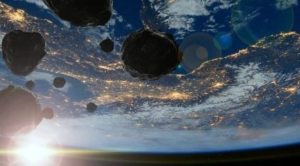
In 2014, the Japan Aerospace Exploration Agency (JAXA) sent a spacecraft called Hayabusa2 on a unique mission. The spacecraft was tasked with landing on an asteroid named Ryugu and to collect rock samples from it.
The spacecraft successfully completed its mission in 2020 when it returned with rock samples. In addition to collecting samples, the spacecraft also landed rovers, hit it with projectiles and spent months observing it closely. And now, after spending time analyzing the sample, scientists have been able to answer a terrifying question. What would happen if the asteroid Ryugu were to strike the Earth?
The reason scientists are asking this question and are trying to find answers is because of two factors. Most of the time, when estimations around the impact of an asteroid strike is calculated, only the speed of the asteroid and the angle of strike is used to make the calculation. One very important aspect, the composition of the asteroid is often ignored.
But scientists are finding out that not all asteroids are created equal. For example, Ryugu is a rubble-pile asteroid and not a rock hard asteroid. It means how this asteroid will react to the upper atmosphere will be different from how rocky asteroids would.
The second factor is that scientists do not get to analyze and see an asteroid up close which has not been affected by the heat and pressure of entering the atmosphere. This means that the data derived from studying a pristine asteroid can give really important insight into these space rocks.
Can asteroid Ryugu destroy the Earth
Asteroid Ryugu has been measured at roughly 900 meters width. As per NASA, any asteroid that is 1 kilometers wide can trigger a global extinction event. But the answer is a little tricky to find in this case.
?Hayabusa2 succeeded in an experiment in which two 1 kilogram [2.2 pounds] projectiles were launched at a speed of 2 kilometers per second [1.2 miles per second] resulting in the formation of a crater approximately 20 meters [66 feet] in diameter. The cohesion strength of the rock was meant to be very very low. The density is just a little higher than water with a very high porosity estimated,? JAXA Department of Solar System Sciences professor Satoshi Tanaka told Space.com.
Such asteroids are known as rubble-pile asteroids and they will never reach the Earth’s surface in a single piece. They are more likely to break apart in the lower atmosphere. Interestingly, we have seen such an asteroid entering the atmosphere a few years ago. The Chelyabinsk meteor was a rubble-pile asteroid and it exploded in an airburst about 35 to 40 kilometers above the ground. It was later calculated that the atmospheric blast released an energy roughly equivalent to 400?500 kilotons of TNT. It is about 33 times the intensity of the blast of the nuclear bomb that flattened Hiroshima.
And here’s the kicker. The Chelyabinsk meteor was about 19 meters in width. That’s just 2 percent of the size of Ryugu. So, if Ryugu were ever to hit the Earth, just the airburst itself would be catastrophic, let alone all the small pieces of the asteroid that later bombard the surface of the planet.
Luckily for us, according to estimates, there is no chance of this particular asteroid striking our planet in the near future




 Driving Naari Programme launched in Chandigarh
Driving Naari Programme launched in Chandigarh






























